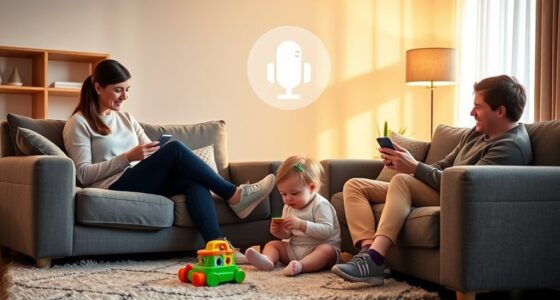The next generation of teachers is being prepared to seamlessly integrate chatbots and AI tools into their classrooms. Schools are offering more AI training, and future educators are learning how to use these technologies to create engaging lessons and personalized learning experiences. This shift aims to modernize teaching methods and improve student outcomes. If you keep going, you’ll uncover how this transformative approach is shaping the future of education and teacher roles.
Key Takeaways
- Future teachers are receiving specialized training to integrate chatbots into their pedagogy effectively.
- Schools and higher education institutions are planning or implementing AI training programs for new teachers.
- About 74% of districts intend to offer AI training by 2025, preparing educators for AI-enhanced classrooms.
- Teacher training includes learning how to design AI-proof assignments and utilize chatbots for personalized learning.
- The focus is on equipping the next generation of teachers to seamlessly incorporate AI tools into everyday teaching practices.

Have you wondered how the next generation of teachers is transforming education with chatbots? Today, more educators are embracing AI tools like ChatGPT, reflecting a shift towards modernized teaching practices. Nearly two-thirds of teachers plan to increase their use of ChatGPT, demonstrating growing confidence in AI’s potential to enhance the classroom experience. Within just two months of its introduction, over half of teachers started using ChatGPT, with 40% engaging with it weekly or more. Many incorporate AI tools daily, though about a third remain cautious or haven’t adopted them actively yet. Surprisingly, teachers are almost four times more likely to permit students to use ChatGPT than to catch them doing so without permission, signaling a move toward acceptance and trust. The use of AI tools in classrooms has increased significantly, with 57% of educators now integrating them into their teaching routines. Black and Latino teachers are leading the way, reporting higher usage rates—around 69%—compared to other demographics. This indicates a broader, more inclusive adoption of AI across different communities. Meanwhile, school districts are preparing for this shift by planning to offer AI training, with 74% expecting to do so by 2025, up from less than half in 2023. However, actual training remains limited; only 19% of primary teachers reported AI use during their own training, and many admit their exposure has been sporadic rather than sustained. Higher education institutions are fully committed, with every institution planning or implementing generative AI initiatives, and nearly a third have concrete plans for AI investments within a year. Teachers recognize the benefits of chatbots, especially for generating lesson plans and classroom ideas quickly. They also use AI to create personalized assignments and learning resources, helping to modernize teaching methods. This growing adoption is driven by a recognition of AI’s potential to improve educational outcomes. Both students and teachers see ChatGPT as a tool for engaging digital learners and revitalizing pedagogy, not just a way to cut corners. But challenges remain: about a quarter of teachers have caught students cheating with AI, and some districts have restricted access to prevent misuse. Many educators now spend time detecting AI-generated work and redesigning assignments to be AI-proof. Despite widespread adoption, most teachers see AI as a helpful supplement rather than a core component of future education. Education professionals acknowledge uneven implementation based on school types, with suburban teachers generally more engaged than their urban or rural counterparts. As generative AI continues to evolve, the next generation of teachers is being trained to integrate chatbots seamlessly into their teaching practices, shaping a more connected and innovative classroom landscape.
Frequently Asked Questions
How Effective Are Chatbots Compared to Traditional Teaching Methods?
Chatbots can be quite effective, especially for personalized learning and providing 24/7 access to resources. You’ll find they enhance theoretical understanding and motivate students through interactive methods. However, they’re less effective for hands-on skills and clinical reasoning. Combining chatbots with traditional teaching boosts outcomes, but you should oversee their use to avoid errors and superficial learning. Overall, chatbots are a valuable supplement, but not a complete replacement for traditional methods.
What Skills Do Future Teachers Need to Operate Chatbots Effectively?
To operate chatbots effectively, you need a blend of technical, pedagogical, ethical, and communication skills. Master AI basics, troubleshoot tech troubles, and customize content to meet curriculum needs. Design engaging, educational interactions that support student learning. Stay vigilant about privacy and bias, and clearly communicate chatbot use. Develop digital literacy, analyze data, and balance tech tools with human touch, ensuring responsible, inclusive, and effective teaching with chatbots.
Are Chatbots Personalized to Individual Student Learning Styles?
Yes, chatbots are personalized to individual student learning styles. They analyze student data and adapt content, feedback, and explanations to match each learner’s needs. You’ll see chatbots engaging visual, auditory, or kinesthetic learners through multimodal interactions, providing tailored assessments and real-time support. This personalization helps boost motivation, retention, and understanding, making learning more effective and inclusive for diverse student profiles.
How Do Chatbots Handle Sensitive or Complex Student Issues?
When handling sensitive or complex student issues, chatbots provide initial support and escalate cases to human advisors when needed. They use protocols to identify situations requiring empathy or critical thinking, like mental health concerns. You should monitor their responses regularly, ensuring they meet evolving student needs. Combining AI efficiency with human oversight helps address nuanced problems effectively while maintaining privacy and ethical standards.
What Are the Privacy Concerns Related to Using Chatbots in Education?
You should be aware that using chatbots in education raises serious privacy concerns. They often collect and store personal student data, like grades, attendance, and sensitive info, without clear transparency or security. Data may be retained long-term, shared unintentionally, or used to train AI models. With outdated laws and weak enforcement, your students’ privacy is at risk of exposure, misuse, or identity theft, making cautious use essential.
Conclusion
As you step into this new era, you’re like a pioneer charting unfamiliar waters with a trusty compass—chatbots. They’ll become your partners in guiding students, making learning more interactive and personalized. Embracing this technology isn’t just about keeping up; it’s about transforming education into an engaging journey. Together with chatbots, you’ll inspire the next generation of learners, turning classrooms into vibrant worlds where curiosity and innovation thrive. The future of teaching is here, and you’re at the forefront.









